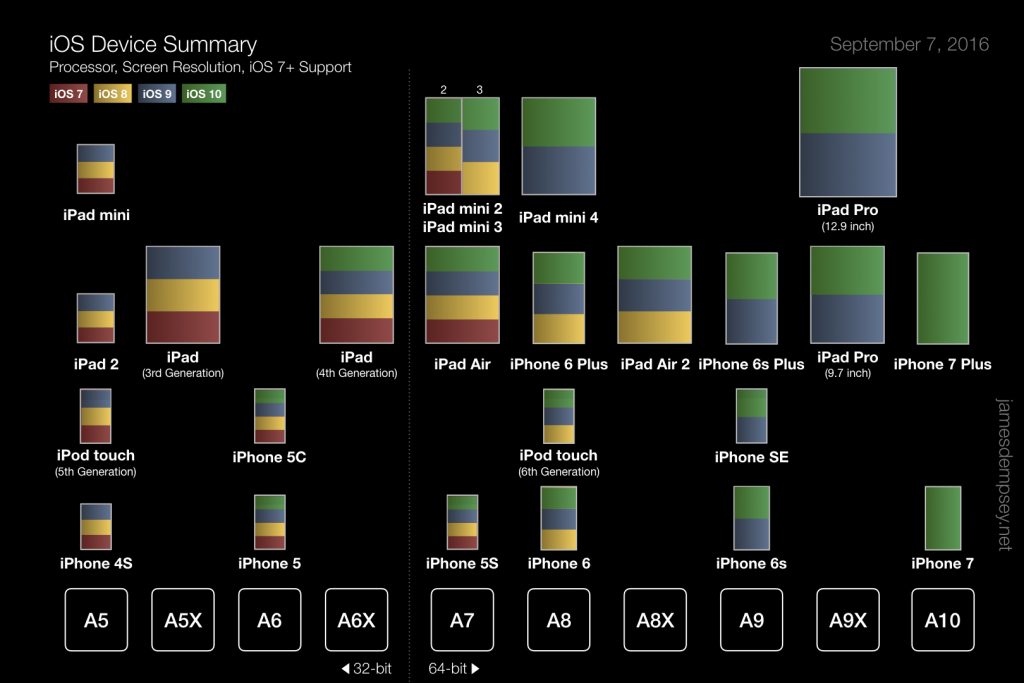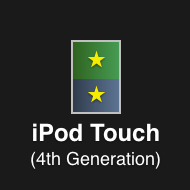iOS Device Summary
One challenge as a small independent iOS developer is keeping up with evolving hardware. Some testing can be done in the iOS Simulator, but to see how an app truly behaves, it is important to develop and test on actual devices. This is especially true of performance—things that feel snappy in the simulator can be noticeably slower on the device.
I created this summary chart as a way to visualize a few key iOS device properties. This has helped me decide which mix of devices I use to get reasonable coverage for development and testing. I’ve found it useful and hope others will also.
 The key device properties represented are processor, screen resolution and supported iOS versions.
The key device properties represented are processor, screen resolution and supported iOS versions.

On my copy of the chart, I use a star to indicate that I have a particular device running a particular iOS version. This makes it easy to see at a glance what coverage I have across all three properties.
The devices are organized primarily by processor. Each processor represents a system-on-chip containing both CPU and GPU, making it a reasonable indicator of system performance. I tend to develop on devices with slower processors, to ensure code performs well across all devices.
The rectangle for each device is a scaled version of its screen resolution, preserving aspect ratio and relative size to other devices. This represents the number of pixels, not the physical screen size. This is why the rectangle for an iPhone 4s with a retina display (960 x 640) is just a little smaller than rectangle for the iPad 2 (1024 x 768).
Supported iOS versions are indicated by color inside the rectangle for each device. This summary includes iOS 6 and later. Since system changes that impact your app can happen between releases, it is important to test on all the OS versions you support. Additionally, because reverting a device to a previous iOS version is not officially supported, it is also important to track which of your devices are running which iOS version. You want to avoid, for example, accidentally upgrading your only iOS 6 device.
This summary is designed with general iOS development in mind. Apps that depend on particular hardware features obviously have different criteria for choosing devices for development and testing. Feel free to download a copy of the summary below. I hope you find it useful and welcome your feedback. •
Update: I’ve gotten a number of requests for a printer-ready version of the chart with a white background. I’ve added versions for color and black & white printers below.
Update 2: Updated links below. You can download the most recent version of the summary as well as past versions for the more history-minded.
Latest PDF Downloads:
Previous PDF Downloads:
- _iOS Device Summary (Mar 21, 2016)
_ - iOS Device Summary for Color Printers (Mar 21, 2016)
- _iOS Device Summary (Sep 9, 2015)
_ - iOS Device Summary for Color Printers (Sep 9, 2015)
- _iOS Device Summary (Jul 15, 2015)
_ - iOS Device Summary for Color Printers (Jul 15, 2015)
- _iOS Device Summary (Jun 8, 2015)
_ - iOS Device Summary for Color Printers (Jun 8, 2015)
- _iOS Device Summary (Oct 16, 2014)
_ - iOS Device Summary for Color Printers (Oct 16, 2014)
- _iOS Device Summary (Sep 9, 2014)
_ - iOS Device Summary for Color Printers (Sep 9, 2014)
- _iOS Device Summary (Jun 13, 2014)
_ - iOS Device Summary for Color Printers (Jun 13, 2014)
- _iOS Device Summary (Oct 22, 2013)
_ - iOS Device Summary for Color Printers (Oct 22, 2013)
- _ iOS Device Summary (Sep 10, 2013)
_ - iOS Device Summary for Color Printers (Sep 10, 2013)
- _ iOS Device Summary (Jun 21, 2013)
_ - iOS Device Summary for Color Printers (Jun 21, 2013)
- _ iOS Device Summary (Oct 23, 2012)
_ - iOS Device Summary for Color Printers (Oct 23, 2012)
- _ iOS Device Summary (Oct 8, 2012)
_ - iOS Device Summary for Color Printers (Oct 8, 2012)
- iOS Device Summary for B&W Printers (Oct 8, 2012)